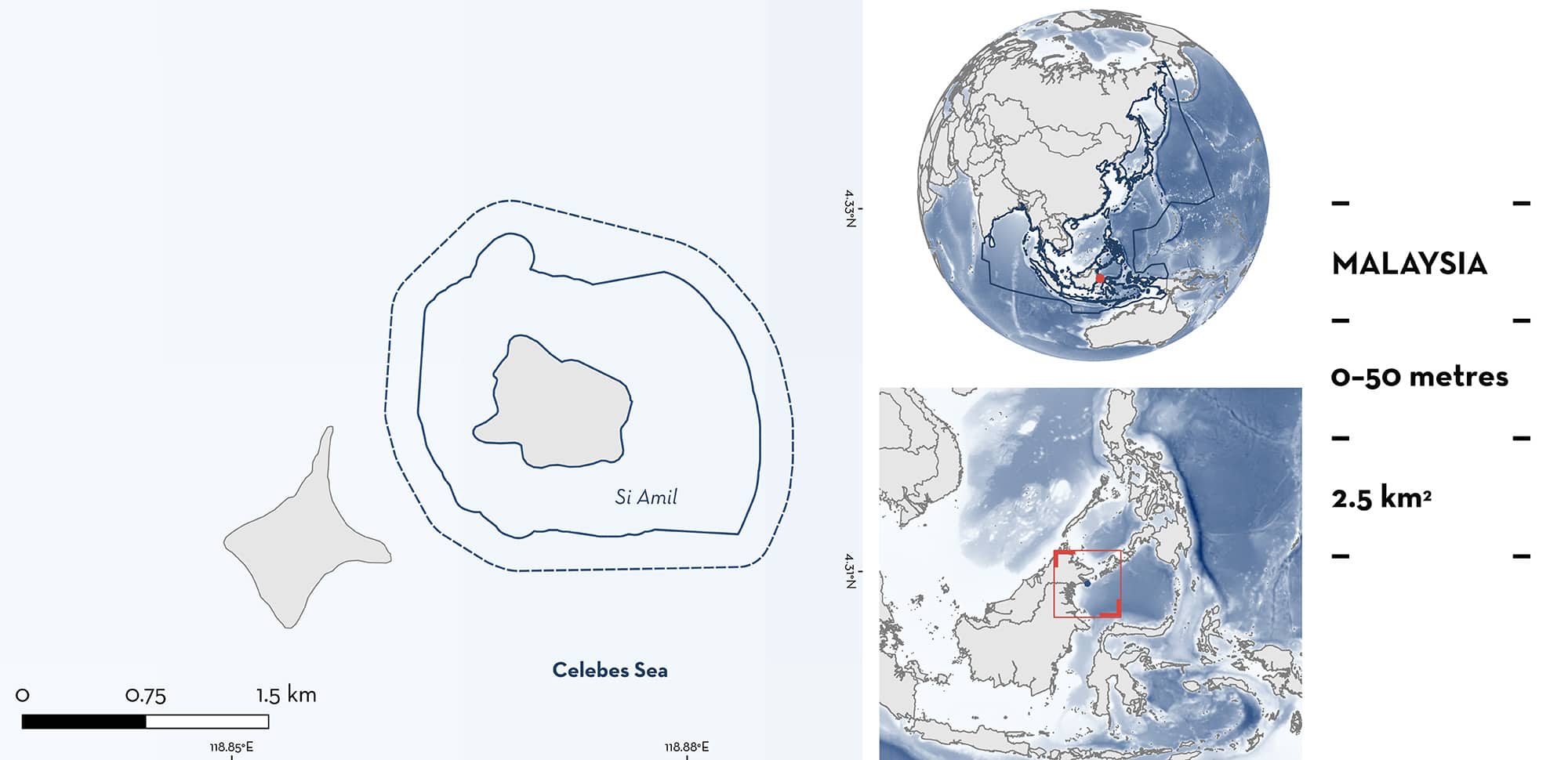ISRA FACTSHEETS
ISRA FACTSHEETS
ASIA REGION
Si Amil
Summary
Si Amil is located ~30 km off the town of Semporna in southeast Sabah, Malaysia. This small reef is close to the shelf edge and is influenced by monsoonal climate. The habitats in this area are characterised by shallow coral reef tops, sloping reef walls, pinnacles, and pelagic waters. Si Amil overlaps with the Sipadan Islands Key Biodiversity Area and lies within the Sulu-Sulawesi Marine Ecoregion Ecologically or Biologically Significant Marine Area. Within this area, there are: threatened species (e.g., Spotted Eagle Ray Aetobatus ocellatus) and undefined aggregations (e.g., Shorthorned Pygmy Devil Ray Mobula kuhlii).
Download factsheet
Si Amil
DESCRIPTION OF HABITAT
Si Amil lies ~30 km from Semporna in the southeast corner of Sabah, Malaysia. This small area comprises a single reef that surrounds Si Amil Island and is characterised by shallow reef tops, sloping reef walls, pinnacles, and pelagic waters. It is situated <1 km from the shelf edge and is exposed towards the east. On that exposed eastern side of the area lies the ‘Pinnacle’ dive site, which are two pinnacles that rise from a gently sloping plateau at ~50 m depth to 30 m (McCann et al. 2021). The area is influenced by the monsoon seasons, with the southwest monsoon in May–September and the northeast monsoon in November–March (Abdul-Hadi et al. 2013).
Si Amil is part of the Semporna Priority Conservation Area (PCA), overlaps with the Sipadan Islands Key Biodiversity Area (KBA 2024), and lies within the Sulu-Sulawesi Marine Ecoregion Ecologically or Biologically Significant Marine Area (EBSA; CBD 2024).
This Important Shark and Ray Area is benthopelagic and extends from inshore and surface waters (0 m) to 50 m based on the bathymetry of the area and the global depth range of the Qualifying Species.
CRITERION A
VULNERABILITY
Two Qualifying Species considered threatened with extinction according to the IUCN Red List of Threatened Species regularly occur in the area. These are the Endangered Shorthorned Pygmy Devil Ray (Rigby et al. 2022) and Spotted Eagle Ray (Finucci et al. Submitted).
CRITERION C
SUB-CRITERION C5 – UNDEFINED AGGREGATIONS
Si Amil is an important area for undefined aggregations of two ray species.
Shorthorned Pygmy Devil Rays are seen in schools of up to 100 individuals in this area (McCann et al. 2021). In a study undertaken from May 2014 to July 2015 with 332 dives in the area, Shorthorned Pygmy Devil Rays were seen 122 times and 48 aggregations of 10 or more individuals were recorded (mean school size = 34.3 individuals) (McCann et al. 2021). Aggregations were seen in all surveyed months except in October, with a seasonal peak from June to September. Since that study, dive guides have continued to report schools of Shorthorned Pygmy Devil Rays in Si Amil (A Fatta pers. obs. 2023). The species is seen across the area, but most are observed at the ‘Pinnacle’ dive site. Additionally, fishers on nearby Denawan Island reported catching several hundred individuals of Shorthorned Pygmy Devil Rays on occasion (A Fatta pers. obs. 2023). It is possible that the area is important for their reproduction, with courtship sometimes reported and a female with mating scars recorded (C & D McCann pers. obs. 2023), but further surveys are needed to understand the nature and function of these aggregations.
The same 2014–2015 surveys recorded 24 aggregations of Spotted Eagle Rays in Si Amil (C & D McCann unpubl. data 2024). Aggregations were recorded in all months except in March. Between 3–32 individuals were seen in aggregations, with a mean of 7.6 individuals. Dive guides continue to report aggregations of eagle rays (A Fatta pers. obs. 2023). The reason for these aggregations is not yet understood.
Download factsheet
SUBMIT A REQUEST
ISRA SPATIAL LAYER REQUEST
To make a request to download the ISRA Layer in either a GIS compatible Shapefile (.shp) or Google Earth compatible Keyhole Markup Language Zipped file (.kmz) please complete the following form. We will review your request and send the download details to you. We will endeavor to send you the requested files as soon as we can. However, please note that this is not an automated process, and before requests are responded to, they undergo internal review and authorization. As such, requests normally take 5–10 working days to process.
Should you have questions about the data or process, please do not hesitate to contact us.


